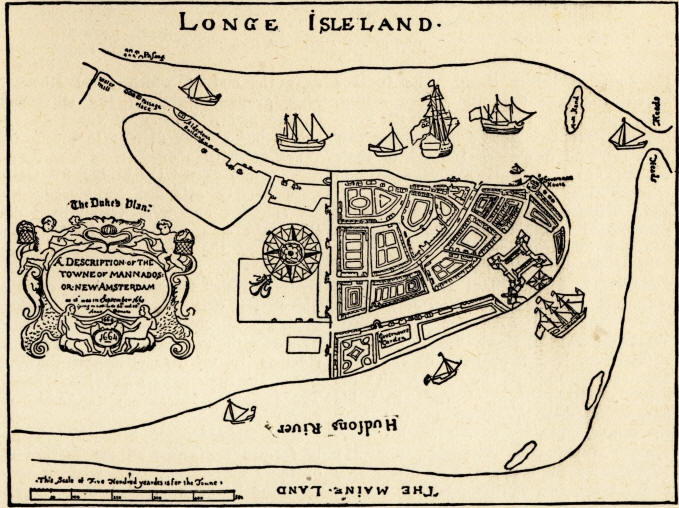New Amsterdam
|
|
This Site:
|
1661 Map of New AmsterdamNew Amsterdam. The village that grew around the trading-post on Manhattan Island was called Manhattan until the arrival of Governor Stuyvesant in 1647, when it was called New Amsterdam. Fort Amsterdam, a large work " with four angles," and faced with solid stone, had been built by Governor Minuit on the southern point of the island. The village grew apace. Its ways were crooked, its houses straggling, and its whole aspect was unattractive until, under the new administration, improvements were begun, when it contained about 800 people. They were under the immediate government of the director-general and there was much restiveness under the rigorous rule of Stuyvesant, who opposed every concession to the popular will. They asked for a municipal government, but one was not granted until 1652, and in 1653 a city government was organized, much after the model of old Amsterdam, but with less political freedom. The soul of Stuyvesant was troubled by this " imprudent intrusting of power with the people." The burghers wished more power, but it could not then be obtained. A city seal and a " silver signet " for New Amsterdam, with a painted coat-of-arms, were sent to them from Holland. The church grew, and as there were freedom and toleration there in a degree, the population increased, and the Dutch were soon largely mixed with other nationalities. When a stranger came, they did not ask him what was his creed or nation, but only, Do you want a lot and to become a citizen ? The Hollanders had more enlarged views of the rights of conscience than any other people at that time. New, like old, Amsterdam became quite a cosmopolitan town. Of the latter, Andrew Marvell quaintly wrote:
When New Amsterdam was surrendered to the English (1664) it contained more than 300 houses and about 1,500 people. On the return of Governor Stuyvesant from his expedition against the Swedes on the Delaware he found the people of his capital in the wildest confusion. Van Dyck, a former civil officer, detected a squaw stealing peaches from his garden and killed her. The fury of her tribe was kindled, and the long peace of ten years with the natives was suddenly broken. Before daybreak on Sept. 15, 1655, almost 2,000, chiefly of the River Indians, appeared before New Amsterdam in an immense flotilla of canoes. They landed and distributed themselves through the town, and, under the pretence of looking for Northern Indians, broke into several dwellings in search of Van Dyck. The people immediately assembled at the fort, and summoned the leaders of the invasion before them. The Indians agreed to leave the city before sunset. They broke their promise, and in the evening shot Van Dyck. The inhabitants flew to arms, and drove the Indians to their canoes. They crossed the Hudson and ravaged New Jersey and also Staten Island. Within three days 100 white people were killed, and 150 were made captives. See NEW NETHERLAND ; NEW YORK. |
|
|
||
|
|
Site Copyright 2003-2018 Son of the South. For Questions or comments about this collection, contact: paul@sonofthesouth.net |
|
|
Are you Scared and Confused? Read My Snake Story, a story of hope and encouragement, to help you face your fears. |
||
